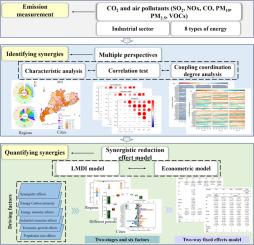更有效的协同作用,以减少经济活跃地区的碳和空气污染物
IF 10.9
1区 环境科学与生态学
Q1 ENGINEERING, ENVIRONMENTAL
引用次数: 0
摘要
识别和量化连接CO2和空气污染物(APs)的关键污染物是实现有效协同效应的关键,但现有的研究非常有限。因此,本研究提出了一个旨在提高CO2和APs协同减排效率的“EIQ”综合分析框架。从多个角度识别出与CO2协同效果最好的ap,并结合LMDI和计量经济模型构建CO2与ap的定量评价模型。我们将“环境质量评价”框架应用到广东的工业领域。经济发达地区CO2与APs之间的协同效应更大。在2012-2021年期间,与其他ap相比,NOx与CO2表现出较高的协同效应。随着时间的推移,协同效应对NOx减排的贡献逐渐增加。二氧化碳减排显著影响氮氧化物减排,每减少100万吨二氧化碳可减少1873吨氮氧化物。本文章由计算机程序翻译,如有差异,请以英文原文为准。

More effective synergies to reduce carbon and air pollutants in economically dynamic regions
Identifying and quantifying the key pollutants that link CO2 and air pollutants (APs) is critical to achieving effective synergistic effects, yet existing research is very limited. Therefore, this study proposed an "EIQ" comprehensive analysis framework aimed at improving the efficiency of synergistic emission reduction of CO2 and APs. It identified the APs with the best synergistic effect with CO2 from multiple perspectives, and then constructed a quantitative assessment model for CO2 and APs by combining the LMDI and econometric model. We applied the "EIQ" framework to the industrial sector of Guangdong. Economically developed regions exhibit greater synergistic effects between CO2 and APs. NOx shows a high synergistic effect with CO2 compared to other APs during 2012-2021. The contribution of the synergy effect to NOx emission reduction gradually increases over time. CO2 emission reduction significantly affects NOx emission reduction, with every 1 Mt decrease in CO2 reducing NOx by 1873 tons.
求助全文
通过发布文献求助,成功后即可免费获取论文全文。
去求助
来源期刊

Resources Conservation and Recycling
环境科学-工程:环境
CiteScore
22.90
自引率
6.10%
发文量
625
审稿时长
23 days
期刊介绍:
The journal Resources, Conservation & Recycling welcomes contributions from research, which consider sustainable management and conservation of resources. The journal prioritizes understanding the transformation processes crucial for transitioning toward more sustainable production and consumption systems. It highlights technological, economic, institutional, and policy aspects related to specific resource management practices such as conservation, recycling, and resource substitution, as well as broader strategies like improving resource productivity and restructuring production and consumption patterns.
Contributions may address regional, national, or international scales and can range from individual resources or technologies to entire sectors or systems. Authors are encouraged to explore scientific and methodological issues alongside practical, environmental, and economic implications. However, manuscripts focusing solely on laboratory experiments without discussing their broader implications will not be considered for publication in the journal.
 求助内容:
求助内容: 应助结果提醒方式:
应助结果提醒方式:


